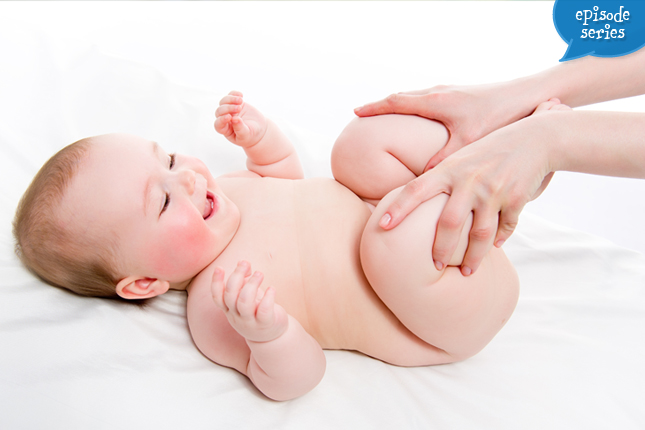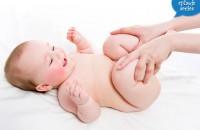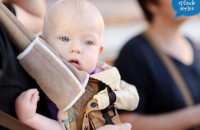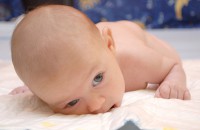Parent Savers
Baby Skin Conditions: Common Skin Irritations
[00:00:00]
Please be advised, this transcription was performed from a company independent of New Mommy Media, LLC. As such, translation was required which may alter the accuracy of the transcription.
[Theme Music]
DR. AHMAD BAILONY: A baby’s skin is a marvelous wonder providing protection; nutrients and more to their growing bodies while feeling gentle to the touch. But whether through outside influences or from practice that can’t be controlled, it’s nearly inevitable that infants will experience some sort of skin irritation. Today, we’ll talk about some of the most common skin irritations for babies. I’m Doctor Ahmad Bailony and this is parent savers episode 86.
[Theme Music/Intro]
JOHNER RIEHL: Happy new year, everybody and welcome to Parent Savers, Broadcasting from the Birth Education Center San Diego. Parent Savers is your weekly online on the go support group for parents of newborns, infants and toddlers. I’m your host, Johner Riehl. Thanks again to all of our loyal listeners who join us week in and week out. And thanks also to those of you who are listening for the first time. As you may know, you can join our Parent Savers club and receive access to special bonus content after each new show plus special give aways and discounts from time to time. And If you haven’t already, please make sure to download the free Parent Savers app available in the android and iTunes market place so you can automatically have access to the great parenting advice and conversation we have on Parent Savers every week.
Let’s start this week’s conversation by meeting everyone who is joining us in studio. I want to introduce myself first, as you know, I’m Johner Riehl. I have three boys, a 6-year old, a 4-year old, and a two-year old. And we’re joined with a pretty full house in the studio today
ANNIE LAIRD: My name’s Annie Laird, I’m 35, I’m a teacher and I have three children, all girls so an 8-year old, a year and a half old, and then a one month old. So, we’re busy.
JOHNER RIEHL: Through the yin to the yang
ANNIE LAIRD: Yes, exactly.
RACHEL ROBINSON: My name is Rachel Robinson, I am 25, I currently work as a birth doula. I have one little boy, he is about two and a half now.
ERIN ESTEVES: And I’m Erin Esteves, Otherwise known as O. G Mama Sita, no need to divulge my age, but yeah. Geriatric mom.
JOHNER RIEHL: You could just listen to a previous episode if you just close it
ERIN ESTEVES: I just couldn’t remember at the moment. That’s, that’s all. I have one son, two years old named Cash.
JOHNER RIEHL: Right. Alright, thanks for joining us. Happy new year, everybody!
[Theme Music]
JOHNER RIEHL: Alright before we jump in today’s topic, we’re going to look at an app that is good for families or maybe it’s not. That’s what we’re here to talk about. The app we’re looking at today is called Family Chat from Tag Along K. And it’s available for iPhone, you need to have IOS 7, I believe. No actually it works for iPhone 5 and later IOS 7 it’s called Family Chat, it’s a dollar 99. And what it is, is it’s really just conversation starters. It’s actually a really simple app, as far as the functionality of it goes. On the screen it pops up a question that might get you guys talking or you can favorite questions so that you can go back to them maybe in different groups. As I pull up the app right now, it just the question is there ever a time when you shouldn’t be completely honest. Since those types of questions that we could really spark a conversation around the table. Have you guys had a chance to look at it?
RACHEL ROBINSON: Yeah, I went through it. There are a lot of questions, just really simple stuff but I think that could spark some kind of conversation. It definitely, It’s a really simple app to use, and I think it’s actually a really good idea for families to come up with some things to talk about around the table.
JOHNER RIEHL: Yeah it felt, it felt like oh where do I take notes about it, but that’s not the point. The point is that you ask a question right where it wants answers instead you’re talking, actually. Instead of just looking at the phone.
ANNIE LAIRD: Well since everybody already is, has their phone now in front of them, and is staring down, anyways, join them. Well you can at least then you have your phone right in front of you and talk to your family members if you actually like each other. So, yeah.
DR. AHMAD BAILONY: Is it better than playing Candy Crush?
RACHEL ROBINSON: Yes, definitely. I like the fact that you can pay for a certain questions as well, ‘cause some of them are like ‘what is your idea of a fantastic ice cream sundae’ I would like to know about that, all the time. I love ice cream, my kids love ice cream. Yeah, just like you said, John. It’s really easy to use and I like that.
ERIN ESTEVES: I’m just wondering about, if you’re already in an awkward situation, and does pulling out your phone, you know going to an app, does it kind of like, increase the awkwardness?
JOHNER RIEHL: Well it’s, I mean, well it’s called family chat. So I mean, I guess that’s implying that your family is kind of awkward.
ERIN ESTEVES: I guess thinking about when I was a teenager, had my dad pulled something out like that, the eyes would’ve rolled so far back at my head.
JOHNER RIEHL: He could have done anything and your eyes would’ve rolled.
ERIN ESTEVES: And that’s my point, exactly! So, I don’t know I’m just being a devil’s advocate here
JOHNER RIEHL: Yeah, no, I mean I think it’s cool. I mean I think that there’s like I said, it feels on the surface as someone who uses a lot of apps. Where there’s a dozen two more, but that’s kind of the point. It’s an app that can also be really useful for people who are kind of afraid I think of, too dependents on the phone or too much apps ‘cause really, it’s about real world interaction not interaction with the phone. The phone is the facilitator.
RACHEL ROBINSON: Yeah, I liked what Annie said about how everybody already has their phone out anyway, so really, it’s kind of norm now. To have your phone out and people look at things like this. So I don’t know how awkward it will be.
JOHNER RIEHL: Pretty much any interaction I had with Erin’s awkwardness.
ERIN ESTEVES: True, true.
JOHNER RIEHL: It’s a dollar 99, what do you guys say, thumbs up or thumbs down? I say thumbs up.
RACHEL ROBINSON: I say thumbs up, definitely.
ANNIE LAIRD: Thumbs up as well.
ERIN ESTEVES: Yeah, I’m in the middle.
JOHNER RIEHL: Awkward! Alright, thanks. Definitely check it out, we’ve got a link to it on this episode page.
[Theme Music]
JOHNER RIEHL: Today’s topic is baby’s skin conditions, talking about common skin irritations. And today we’re talking with Dr. Ahmad Bailony. I, I thought it was bye-low-ny but it’s actually Bye-loo-ny
DR. AHMAD BAILONY: It’s okay people call me baloney growing up.
JOHNER RIEHL: Sure you can imagine what happens with a name like Johner, as well. We’re going to talk about these skin conditions, so thanks for joining us.
DR. AHMAD BAILONY: Thank you for having me.
JOHNER RIEHL: What are the skin ailments we’re going to be talk about today?
DR, AHMAD BAILONY: So today, we’re just going to narrow down a 6, but in reality there’s a ton. The six we’ll be talking about today are Impetigo, Prickly heat, which is more commonly known as heat rash, Eczema, Seborrhea, which is more commonly known as Cradle Cap, Contact Dermatitis and then also Diaper Rashes.
JOHNER RIEHL: And we could probably spend like a whole episode talking about each of these. In fact we did, with you, last year. Looking at Eczema, but I think that the idea on this one is the baby’s, their skin is very sensitive. And stuff’s going to happen to them. And so this is a look at some of the most common things and maybe stuff’s happening to their kids and these are some things to look for.
DR. AHMAD BAILONY: Baby’s skin is very sensitive really. When you think about your skin is your largest organ and I think people kind of forget this and it’s immature on babies’ kind of everything else. So, you know. Even on myself when I think of rashes always freak people out. If I wake up one morning and I see something on my arm, I start Googling and the it right scare myself which is strange for a doctor. So you can imagine when it’s on your baby, I’m sure it’s a very scary event for a parent.
JOHNER RIEHL: Totally. And I remember with I mean, pretty much with all my kids when they’re born just marveling at the fact that you know, 12 hours ago, that skin was just in the nice fluid, calm, maybe it was a calm 12 hours ago. Things are pretty crazy 12 hours ago. But now, it’s being subjected to everything in the environment for the first time.
DR. AHMAD BAILONY: Right, and I think, you know, at the end of the day, it’s gonna be a very difficult to talk about skin rashes because you can’t actually see them. But I think it’s an important topic, because it’s probably, I probably talked to parents about their baby and their skin at least, I would say, ten times a day which yeah.
JOHNER RIEHL: And so parents come in and they’re just like, ‘what is this?’
DR. AHMAD BAILONY: oh yeah well, that’s just, the most common thing. With rash, that’s all it says in the chief complaint.
JOHNER RIEHL: Got it.
RACHEL ROBINSON: right.
JOHNER RIEHL: And or so rashes could be a ton of different things.
DR. AHMAD BAILONY: Rashes can literally be a ton of different things.
JOHNER RIEHL: Well so the first one, was Impetigo. So what is that? I usually have no idea about what Impetigo is but I’ve heard it.
DR. AHMAD BAILONY: So it’s interesting that we’re starting with Impetigo. It’s not actually as common in babies. We actually see it more in preschool and kindergarten children but you can see it in babies. And basically what it is it’s a superficial skin infection. So we’re not talking about something like you know, like an abscess or a boil that’s thickened gross. It’s like a very superficial crusty looking skin infection. When it comes to Impetigo, there are actually two kinds; there’s a blistery kind- that one always freaks people out, because that one looks like a giant balloon on your skin.
JOHNER RIEHL: okay
DR. AHMAD BAILONY: Okay. And then there is a crusty kind where if you can imagine almost like a bug bite that split open and is kind of crusty and weepy
JOHNER RIEHL: yeah.
DR. AHMAD BAILONY: looks like that. Not a scary to the parents usually but they do come in say ‘ I wonder what’s going on with my child ‘
JOHNER RIEHL: What color is the crust?
DR. AHMAD BAILONY: It’s usually like a golden crusted over color
JOHNER RIEHL: okay
ANNIE LAIRD: is it like a fungal type of an infection?
DR. AHMAD BAILONY: it’s bacterial. The most common bacteria we usually see are both staff, which is the big one you hear about in the news all the time. And that also strep which is the same bacteria that gives you strep throat for example.
JOHNER RIEHL: It irritates your throat but your skin it’s irritating but
DR. AHMAD BAILONY: Basically with Impetigo what you’re looking at is there’s some sort of break in the skin or not necessarily break but maybe the skin was just not necessarily hygienic kids. And so there’s [inaudible] for an infection. There’s some sort of original source so one of the big things you could do as a parent to kind of avoid Impetigo in general is to always keep your kid’s skin as clean as you can. Which is easier said than done.
RACHEL ROBINSON: is it somewhere very contagious?
DR. AHMAD BAILONY: It is very contagious, so if you, and usually where you’ll see it, in general you could see it all over , you could see it on the head but in general, we usually see it on the face like on the cheeks or very close to the lips. So if you ever see circular honey-crusted looking things which is the more common form, then you should probably go and get talk to your pediatrician to get it checked out.
JOHNER RIEHL: And so it’s contagious from not only easy to spread like if they scratch it that will help it to spread on their skin but to other people.
DR. AHMAD BAILONY: That’s kind of like the scourge of staph in general. Staph infections I’m sure you know, in the news they’ll scare about like do you know about staph infections and mrsa so it’s contagious. We usually kind of look at other when a for example when a kid comes to me, I see Impetigo I kind of look at everyone else in the room and see if I can see anything. Because it’s fun.
ANNIE LAIRD: There was an outbreak at my toddler’s daycare center and so they had it all posted and of course I had no idea what it was and looked it up online and then saw that it’s not a serious thing. It’s just something that, you know. You could get your kids sent home and it’s a pain in the butt to have to leave work and take them to pediatrician.
DR. AHMAD BAILONY: It’s usually not a serious thing having said that if you know, there are more rare cases where it can be mrsa so it’s a more serious infection. I think it’s always good to never take things lightly when it comes to skin infections. Always see your pediatrician to get those cleared up, because the faster you get them cleared up the less chance of them becoming contagious and spreading.
JOHNER RIEHL: What’s the treatment for this and let me I guess just say, is this going to be similar treatment for all of these or are we going to see kind of different treatments for each one?
DR. AHMAD BAILONY: Thankfully we’re going to see different treatments otherwise this will be boring. But the treatment for impetigo depends on how bad it is. If for example a kid comes in and he has one little lesion on his cheek, then usually you just prescribe a topical antibiotic, put it on a couple of times a day, and that should, kind of localize it. If it’s a kid where he comes in and it’s face is pretty wide spread, and it’s passed on to his little brother, for example. I don’t know why I picked the boy but it’s usually who’s dirtier then we usually use oral antibiotic.
JOHNER RIEHL: Okay. And then they have to soothe the crème and they have keep putting it on or once it cleared up.
DR.AHMAD BAILONY: Once it clears up we usually do it for about a week.
JOHNER RIEHL: okay, thanks. And is everything clear in the and Annie, in your household in the Impetigo front?
ANNIE LAIRD: Yes, right now. For the moment. I’m sure there would be something when I go home here tonight. Some of those skin conditions.
JOHNER RIEHL: She says that as she’s looking at her cellphone.
RACHEL ROBINSON: Checking each kid
ERIN ESTEVES: We didn’t shake hands or anything did we?
JOHNER RIEHL: That’s like a current story I thought that was in the past. Alright, prickly heat is the next one. What is that all about?
DR. AHMAD BAILONY: Prickly heat. I don’t know why it’s called prickly heat. But it’s usually referred to in the more common word as heat rash. This is actually very common in babies. People get little babies and generally when you get a baby for the first time, especially, you’re like freaked out. You’re like, how do I not hurt this thing? And so people tend to bundle up their babies even when it’s summer time. You just don’t want your baby to get cold, that’s kind of what causes it. It’s over bundling, it’s usually the kid who comes in and it looks kind of like little pimples. And it’s usually in covered areas so for example under the kid’s onesie, the parents have wrapped them up all day, they go change the diaper. They lift up and unbutton the onesie and then what is this? There’s a bunch of pimples everywhere. That’s heat rash.
JOHNER RIEHL: Got it
RACHEL ROBINSON: Can it be caused by the baby’s sweating? Too much from being wrapped up, or is more of a dry infection?
DR. AHMAD BAILONY: No, it’s a, well heat rash isn’t generally even an infection, it’s just because a baby’s sweat glands are actually immature, and so they just don’t really handle the heat as well. So while it’s true that you want to keep your baby warm, you don’t want your kid like a frapuccino. At the same time you don’t want to over bundle, because that will cause the heat rash. In general, really, heat rash is not a serious thing. Even when it does happen, a lot of times what parents will tell me for example is, ‘I noticed this rash, there used to be a bunch of dots and now by the time they’ve got in to the doctor, everything’s fine. Generally it’s not serious. If it does persist, then that’s obviously something to see the pediatrician about.
JOHNER RIEHL: That happens to adults too
DR. AHMAD BAILONY: Heat rash does happen in adults, it’s kind of the same deal. It usually happens more in the summer time. Or in San Diego, all year round.
JOHNER RIEHL: Got it. No it’s great. My wife’s grandma, she has this tendency whenever the baby’s around, if she’s cold, then the baby must be cold. And if she’s warm then the baby must be warm. So now if she ever wants to throw blankets it’s hey, we don’t want to give him a heat rash. Don’t want to give him the prickly heat.
DR. AHMAD BAILONY: Babies tend to be very jittery and things especially when you unbundle them around people. Always think that it’s cold, and you kind of remind people baby’s nervous systems are new, so whenever they move it just seems a little more jittery than usual it doesn’t necessarily mean they’re shivering.
RACHEL ROBINSON: Right, right.
JOHNER RIEHL: They’re just trying to figure out if their arm is attached to them.
DR. AHMAD BAILONY: They don’t know it exists.
JOHNER RIEHL: Exactly, so the treatment is really just-
DR. AHMAD BAILONY: The treatment is if you see it, so basically if there’s ever a time, where you unbutton your little onesie, and you see a bunch of pimple looking things on your baby’s skin, the treatment is to just dress them up a little less warm. Not dress them at all, let it breathe and sometimes even like a cooler bath will help. That’s really it.
JOHNER RIEHL: And so the bumps do they have little whiteheads on them?
DR. AHMAD BAILONY: They can be a little red or they can be little whiteheads and sometimes will even break open a little bit
JOHNER RIEHL: Got it.
DR. AHMAD BAILONY: But it goes away.
JOHNER RIEHL: So my wife’s a popper, so what happens when she tries to pop it
DR. AHMAD BAILONY: Do not pop anything on the baby’s skin. Just totally don’t.
JOHNER RIEHL: Her and one of her friends, their instinct is just to they love popping things.
ANNIE LAIRD: I do that.
ERIN ESTEVES: My eyes are just like squinting
JOHNER RIEHL: Yeah so don’t, poppers out there, and we know you’re out there, don’t pop things on the baby’s skin. Alright so let’s close out this segment before we take a break with Eczema. Like I say, we did a whole episode on this before just you know, from a high level. We’ll talk about Eczema.
ERIN ESTEVES: Ah, sorry. Just really quickly wanted to jump in with the question from Facebook regarding Eczema. Well actually, you’ll have to tell me. The question comes from Magdalena Lafayette, and she wants to know that if the baby has red skin under the eyebrows is that Eczema
DR. AHMAD BAILONY: It’s a little bit difficult to answer without actually seeing the baby. But definitely Eczema in babies does present differently than in adult, so in adults and in older kids, you’re going to see Eczema wherever there’s skin folds. Your elbows, your knees, your neck, your groin. In babies, you will see Eczema on the cheeks of the face. So that rash could be Eczema. I’m not going to say it is. Because I can’t see it.
JOHNER RIEHL: Does it have foldy eyelids?
DR.AHMAD BAILONY: But we can see Eczema. So basically what Eczema is, it’s a defect in the proteins of the skin. Your skin’s main job above everything else is to kind of keep the outside world outside. And Eczema’s basically a disease where you have difficulty doing that. So your skin has difficulty with lots of moisture, okay and as a result to that, it does absolutely you think it gets very dry. So you’ll see like, for example in a toddler’s elbow’s, very dry, crusted over skin. And they just can’t stop scratching it and it’s incensing. And it just like, constant irritation. And the skin’s very red and angry looking usually.
ERIN ESTEVES: So another I just got an onslaught of questions for you specifically regarding Eczema.
JOHNER RIEHL: Eczema’s pretty widespread, right?
DR. AHMAD BAILONY: So is Facebook.
ERIN ESTEVES: Well they wanna know what are some home remedies or some things that you can do quickly to kind of alleviate the discomfort.
DR. AHMAD BAILONY: The nice thing about all these skin topics is that there’s tons of home remedies and they actually work, which is good. So first eczema, and specific, the main thing is it’s a problem with moisture. Okay, so it’s very simple steps for example making sure your house is not you know, very hot and swampy, okay. The other thing is if you’re bathing your kid every day, because you feel like they’re smelly kids, with kids who have eczema you might just want to be a little, let them be a little smelly.
JOHNER RIEHL: So the problem with moisture isn’t not enough moisture, it’s too much moisture?
DR. AHMAD BAILONY: It’s the fact that when water touches their skin, okay. The second that it’s not touching their skin so when they get out of the bath for example. They get exposed to that air and it dries really quickly and they have trouble
JOHNER RIEHL: And exposing them to water on their skin just makes it irritating more, right? Got it,
DR. AHMAD BAILONY: The protein on the skin is defective, so it’s not holding the water the way it they should and that causes it to get dried out very quickly especially after the exposure. So basically just bathing less often. The other thing you can do is always moisturize your kid, you know and we’re not talking about the teenage moisturizers that smell like pears and wild fruit. Just unscented, fragrance-free, preservative-free moisturizers. And general over the counter stuff that you can buy homeopathic generally works. All these things are very simple home remedies that you can do before you could step in a pediatrician’s door.
ANNIE LAIRD: Perfect, thanks. That’s going to take me a while to write that out.
JOHNER RIEHL: Our two year old has it really bad. And our four year old I think had it mildly. Have you guys your kids have it?
ANNIE LAIRD: Yeah, my toddler has it and you know what I found I just go to wallgreens or [20:08] and a crème just over the counter real thick crème. And that seems to do the trick for her.
RACHEL ROBINSON: I actually had it myself, so my son does not, I have had it. And usually I just kind of let it be, because I can kind of deal with it and know not to scratch it. I’ve use vanicrème on it sometimes and that has worked pretty well for me too.
DR. AHMAD BAILONY: Yeah, I mean in general with anything you want to use something that’s again fragrance-free, you don’t want any perfumes to it, you also don’t want any preservatives to it, the van crème is very good like you said and then also there’s aqua-fore which I kind of use for everything.
RACHEL ROBINSON: I’ve heard a lot people use that as well.
DR. AHMAD BAILONY: So there’s tons of stuff out there for eczema.
JOHNER RIEHL: But it’s interesting, I feel like we’ve been told that, you know that you even said that it’s kind of different between kids and adults but is it true that kids most likely just grow out of it? Have you heard that before? As we are told by our doctor.
DR. AHMAD BAILONY: There’s kind of debate over this issue, actually. We generally numbers say that about 30% of people will continue to have problems with it, so whether Eczema actually goes away or whether you just stop irritating your skin the way you used to when you were a kid because you really had no control over it, is kind of debatable. But yeah, quote on quote a lot of it is true. It’s just we don’t know if they actually grow out of it like they still have a problem with their skin or they’re just avoiding the factors that they’re causing.
JOHNER RIEHL: Yeah, they’ve learned to manage it. Did you have it?
RACHEL ROBINSON: Yeah, well, for myself I know as a child I definitely had it more frequently compared to how many times it shows up for me now as an adult. And I do agree that, you know my habits obviously are very different now as an adult before when I was a child. And I’ve noticed that it come up a lot less frequently. So it’s still there a little bit but not as often as I had when I was younger.
DR. AHMAD BAILONEY: I would hope your habits were different.
RACHEL ROBINSON: yes.
JOHNER RIEHL: Definitely if you’re interested in this topic, check our archives because we’ve got a whole episode where we talked about it as well. But let’s take a quick break when we come back, we’re gonna talk about Seborrhea, Contact Dermatitis, Diaper rash, and probably if you want, we have even more questions from Facebook as well.
[Theme music/ Intro]
JOHNER RIEHL: Welcome back, everybody to Parent Savers today we’re talking about baby skin conditions and the most common skin irritations with Dr. Ahmad Bailoney. See, I pronounced the wrong part of it. I didn’t get Baloney, alright. Let’s jump right back into the next one which is Seborrhea. So what is Seborrhea? I think my dog had Seborrhea. So I’m not sure what it is. Are kids it’s the same thing?
DR. AHMAD BAILONEY: Seborrhea is what we more commonly call Cradle Cap.
JOHNER RIEHL: Oh.
DR. AHMAD BAILONEY: And it’s very, very common. Some of the statistics actually show that around 3 months of age, about 70% of babies have Cradle Cap. So what Cradle Cap is in case there’s someone out there who’s listening that hasn’t seen it, is it’s a yellow-ish looking greasy kind of scale that grows over the skin. It’s very scaly, very greasy looking. You can google it at the moment and you’ll see a bunch of pictures
JOHNER RIEHL: It’s pretty freaky looking.
DR. AHMAD BAILONEY: Yeah, and it’s not just always on the scalp, that’s the other thing.
JOHNER RIEHL: Oh, really.
DR. AHMAD BAILONEY: So sometimes you’ll see Seborrhea, which we don’t call it Cradle Cap when it’s on the face, but you could. It’s the same kind of thing, It’s a greasy looking thing that you’ll see around the eyebrows, around the nose, around the ears,
ANNIE LAIRD: Oh, my. My infant daughter has that. Oh I didn’t know it was Cradle Cap. See, I learned something today.
DR. AHMAD BAILONEY: So the good news is, that it’s very benign. The one on the face, you really don’t need to do much about it. It’s very, very rare that we need to treat it. It’s just going to take some time. It’ll make her skin a little weird and then disappear.
JOHNER RIEHL: What’s it look like?
ANNIE LAIRD: She’s a weird looking baby, so.
JOHNER RIEHL: I didn’t say that, and I wouldn’t say that.
DR. AHMAD BAILONEY: I’ve never said that to a patient.
RACHEL ROBINSON: Your baby is breathtaking, that’s what you can say.
ERIN ESTEVES: Not always in a good way, right?
JOHNER RIEHL: She has irritations right in the
ANNIE LAIRD: Exactly, like on the bridge of her nose and on the side of her eyebrows, and yeah. I’m also a scratcher along with the popper, so, yeah.
JOHNER RIEHL: But she’s scratching it, should we just leave it be?
DR. AHMAD BAILONEY: So if it’s on the face like that, you can just pretty much just let it be. Just make sure your soaps are unscented, same kind of deal. The one on the actual Cradle Cap on the scalp, that one you can actually treat. Help go away a little bit faster. If you didn’t it would still go away, it just a little more time. But usually what we recommend is either a gentle shampoo something again, fragrance free. Like for example a lot of people use Johnson’s, but if you kind of notice it does have a little perfume. I’ll try and not promote Johnson’s. The other thing you can do to make the Cradle Cap go away is before you shampoo your kid’s hair, you can actually take a little bit of oil. Either mineral oil or you could use baby oil, or you could use olive oil.
RACHEL ROBINSON: Yeah, I’ve heard of olive oil. I’ve heard about that one before.
DR.AHMAD BAILONEY: Just don’t stick your kid’s head in the oven afterwards. But you basically put a few drops on the hair take a little comb, comb the hair and that will kind of loosen up those scales. And then shampoo right after you’ve done that.
JOHNER RIEHL: And then they will kind of disappear? But then, do they kind of come back?
DR. AHMAD BAILONEY: It can come back. It can come back really for the first year. I would say it’s the most common; it’s not as common where we see it after the first year between one and two probably about 5% of kids.
RACHEL ROBINSON: What exactly causes the cradle cap?
DR. AHMAD BAILONEY: We’re not sure, so there is some research studies that show it’s linked to a yeast but it’s not a 100% proven, so we’re not exactly sure. Which is a great answer for me?
RACHEL ROBINSON: If all ends we know how we fix it
DR. AHMAD BAILONEY: The main thing is it’s benign, it’s not an infection. And there’s not much you really have to do if you want to go away or we could just follow simple tips.
JOHNER RIEHL: [Inaudible] specifically designed by some parents in ABC KIDS EXPO that brush away the cradle cap. Its gentle brushes and olive oil. I think they were displaying with all the olive oil selection on the table.
DR. AHMAD BAILONEY: Parents are always like when I tell them olive oil like, ‘are you sure? ‘
JOHNER RIEHL: Alright, Contact Dermatitis. What is that?
DR. AHMAD BAILONEY: So contact dermatitis is what it sounds like. We have these fancy medical words Derm, it’s basically the word for your skin, it is inflammation, so it’s the inflammation of the skin. And the reason why it’s contact, some sort of exposure to something in adults that’s usually like metals, watches, things like that. I would hope your baby is not wearing some fancy watch. So in babies, it’s more common well the reason why Contact Dermatitis happens is because I’m sure you guys have seen those babies with redness right here on the outside of the lip right by where the cheek meets, that’s usually from drool. So the common reason of Contact Dermatitis is drool, you can’t control it and it irritates their skin, they get red. Or Diapers, it’s the same thing. A lot of diaper rashes are actually just contact dermatitis. Because the pees in the diaper it irritates the skin, the skin gets red.
RACHEL ROBINSON: Yeah, my son had that around his mouth when he was an infant. Didn’t know the exact word for it but I did know it’s from the drool.
DR. AHMAD BAILONEY: Very common in one thing, you know, it’s kind of the same concept simple thing you can do to kind of prevent it, Is just put a little barrier there on the outside of the lips something like a petroleum jelly or an aqua-fore. It’s thickened [inaudible]. And when the kid drools, its drool won’t really affect the kid’s skin. You won’t get that redness.
RACHEL ROBINSON: Yeah, that’s why I was told again with the aqua-fore. Kind of just works for a lot of skin irritations.
DR. AHMAD BAILONEY: I mean every now and then you’ll get a kid with really bad Contact dermatitis. They’ve just been drooling forever and no one’s done anything about it. And they come in with really thick, angry skin. And that one we might use like a topical steroid but it’s mild for like a few days.
JOHNER RIEHL: But it’s not bumpy?
DR. AHMAD BAILONEY: It’s just red, it’s just like those cute little baby pictures when the kid’s has some red on the both of the cheeks is because it’s been drooling. So, yeah it might be cosmetically desirable.
ERIN ESTEVES: So Santa has Contact Dermatitis?
JOHNER RIEHL: From the reindeer drool. So they actually mentioned earlier but let’s talk about Diaper rash too. Because I know that’s something you know, probably everybody deals with diaper rash.
DR. AHMAD BAILONEY: So Diaper rash is a huge topic, and you could probably actually have a whole show on it. And I probably deal with it multiple times a day. Not like personally, but with my patients. I’m out of the diaper phase. But basically, there are two kinds of diaper rash. There’s the kind where we just talked about irritation from either the poop or the pee, one of the things I like about my job is I get to say poop and get away with it. And then second kind of diaper rash is not related to diapers at all, it’s like a yeast infection that kids can get. The reason why yeast infections happen is really ‘cause it’s a, there’s a diaper, it’s a warm, humid place. Any place that’s warm and humid and sweaty, they’re likely to start things grow.
JOHNER RIEHL: There’s really just yeast floating around everywhere looking for those places.
DR. AHMAD BAILONEY: Pretty much is
JOHNER RIEHL: That’s crazy
ANNIE LAIRD: So I do have a question from Facebook regarding Diaper rash and it’s from Janine Cook, and she needs to know what she can quickly put on her baby’s diaper rash. She let her suck on some pineapple not knowing how it would affect her bum. She has A and D in coconut oil density wasn’t cutting it. What can she use to soothe it because the baby is in a lot of pain?
JOHNER RIEHL: What does pineapple do to the bum?
ERIN ESTEVES: The doctor?
DR. AHMAD BAILONEY: It’s not because of the pineapple. Sometimes people come in and think this is some sort of allergy, to the food that they ate. Basically we usually we see diaper rash the ages around 9 months and the reason why because kids start eating more foods. And the food just changes the consistency of the poop, so there’s stuff in there that wasn’t in there previously.
ANNIE LAIRD: Does it make it more acidic?
DR. AHMAD BAILONEY: It can, yeah. Anytime it changes consistency of what the skin was used to, then there’s a chance it gets irritated from that. So it’s not like you should stop feeding your kid pineapple but basically what you should do is A you want to look at the rash; if it’s a simple just redness, okay, then that usually is just irritation. If it’s just flat skin and it’s just red, then that’s usually from irritation from you know, the consistency of the stool changing and what you need to do to that is a thing called A&D. What A&D is its petroleum okay. The other thing that’s helpful is any zinc based crèmes. Basically those are like desatins, there’s a ton of brands out there. The most important thing is look at the active ingredient, it either says Zinc or petroleum. Both of those, really what they do is they just form a barrier, okay. The way that you’re going to get rid of a diaper rash is to just have things not touch it for a while so you want to keep a barrier on the skin. You probably also want to give the baby what we call some Diaper breaks, so every now and then be out of the diaper. But you also make sure that you choose these at wise times.
ANNIE LAIRD: Lock your kid in the kitchen where there’s no linoleum or tile floors, it’s easier to clean up, yeah.
DR. AHMAD BAILONEY: Usually for Diaper Rash, there’s the actual ABCD thing that you can do. So the A part is Air, that’s giving your kid a little diaper break. The B part is barrier that’s, what we just talked about with using zinc or petroleum based ointment on there, the C part is the make sure it’s clean so, obviously whenever your kid goes to the bathroom, you want to make sure to try and change the diapers as quickly as you can. And the D part is that in general, there is one time where a disposable diaper are actually better than cloth diapers, and that’s when your kid has a diaper rash. Because Disposable diapers breathe a little bit better, actually. And so obviously it goes along with the air concept so ABCD and kind of make it simple.
ERIN ESTEVES: So I have a question as far as the barriers is concerned. Could you use something like a natural honey? Would that be okay? Because I know it’s antiseptic and it’s also it will keep it moist.
DR. AHMAD BAILONEY: I wouldn’t, it’s one of the things I don’t think it’s researched well enough to actually know. Honey is generally not recommended to eating babies because it could cause [inaudible]. So I would kind of hesitate using it just in case of like an accidental exposure to it, yeah. One thing you can do is what I usually recommend to my patients is if you use something like a zinc-based crème, or petroleum-based crème, you can always put something on top of that. So for example if you use a desatin which is made of zinc, you put that on and then put either the petroleum or like an aqua-fore on top of it, that will kind of seal it in there and then also create another barrier.
JOHNER RIEHL: So these crèmes though, they’re not treating the rash, they’re basically giving the rash time to heal. And these thick substances that are creating a barrier.
DR. AHMAD BAILONEY: So basically the first type of diaper rash like we talked about are just irritations. So the way that you’re going to stop that is by not irritating it anymore. The other type is if you see the diaper rash and it has like small little pimples, to the outside of the redness, so you see like red dots that are actually a sign of a yeast infection. That’s something you want to see your pediatrician about. And add another meditated crème to what’s going on.
JOHNER RIEHL: One of our kids had they got diarrhea real bad. I remember thinking that like the diaper rash was almost like this burn to their skin. And it would, like, blister. And then I’m worried of like oh my gosh, he’s going to have this scar in their from this crazy burn. I mean is that kind of what’s happening? Is the skin’s burning in some sense or is that not really correct?
DR. AHMAD BAILONEY: It’s not necessarily; burning is just getting irritated, if you irritate something enough, your skin’s going to start to react. Your skin is an organ just like we talked about, and it does have you know chemical reaction on things going on that are gonna respond to the irritant. So when your skin gets red and angry, like that it’s just not liking what’s going on. So really, the way to stop that is to stop whatever it is that’s making it angry.
JOHNER RIEHL: It seems like a great a great take away is just you know the fact that these are gonna happen and they happen all the time. In kids in fact it’s almost strange if a kid doesn’t get a skin infection.
DR. AHMAD BAILONY: At the end of the day, the main point is it is scary, you know. If you have a new baby at home, you’ve been preparing for 9 months before this for this baby’s arrival and then one day you wake up and the kid has this scary looking rash and it’s a natural thing to be scared of I think at the end of the day you know the message is, If you’re not sure about it, just go see your pediatrician. Don’t Google and use the internet and put honey and you know.
ERIN ESTEVES: At least I’m not putting butter on everything!
JOHNER RIEHL: There’s a joke in there somewhere. Alright, thanks so much, Dr. Bailoney for joining us today. And for more information for you listeners about baby skin conditions, or for more information about Dr. Bailoney, or any of our panelists, visit the episode page on our website, ParentSavers.com, we’re actually going to continue the conversation for members of our Parent Savers Club after the show, Dr. Bailoney’s going to tell us more about over the counter and some homeopathic treatments for some of these various skin conditions. For more information about Parent Savers Club, visit our website, ParentSavers.com
[Theme Music]
JOHNER RIEHL: Before we wrap up, here’s a parenting oops from one of our listeners.
GRACE: Hello, this is Grace from TrevorStudy, Michigan in United States and one of my favorite funny crinching stories is I was cutting my boy’s hair for summer. And I had my clippers and I’m not a sure stylist but I can do a buzz cut and I did my first on and it was fine and set second son down to give his haircut, well I forgot to put the clipper back on after trimming around my other son’s ears and neck . And I started right in the center at the top of his head. Let’s just say he was not very happy with me it was completely shaved down to his scalp. I pretty much [36:36] it , I just have to shave his whole head. And he was not very happy with me, for a while till it grew out a little bit. But, now he doesn’t like me to cut his hair, and I understand why, it was funny looking back, by the time he was pretty mad at me he was about I think 8 or 9 years old. That was my funny parenting story, alright, bye!
JOHNER RIEHL: If you have a parenting oops you’d like to share on our show, call our voicemail at 6198664775 and leave us a message or send us an email through our site www.parentsavers.com
[Theme Music]
JOHNER REIHL: That wraps up today’s show and we appreciate you so much for listening to Parent Savers. Don’t forget to check our sister shows, Preggie Pals for expecting parents, the boob group for moms who breastfeed their babies, and twin talks for moms with twins which is our very own Sunny Gault who just joined the Twins club. Happy new year, everybody. Next week we’re going to talk about balancing schedules with multiple children, I’m not sure we’re going to solve that problem but we’re going to think about coping strategies most likely. This is Parent Savers, Empowering new parents.
[Disclaimer]
This has been a New Mommy Media production. Information and material contained in this episode are presented for educational purposes only. Statements and opinions expressed in this episode are not necessarily those of New Mommy Media and should not be considered facts. Though information in which areas are related to be accurate, it is not intended to replace or substitute for professional, Medical or advisor care and should not be used for diagnosing or treating health care problem or disease or prescribing any medications. If you have questions or concerns regarding your physical or mental health or the health of your baby, please seek assistance from a qualified health care provider.
[00:37:39]
[End of Audio]












